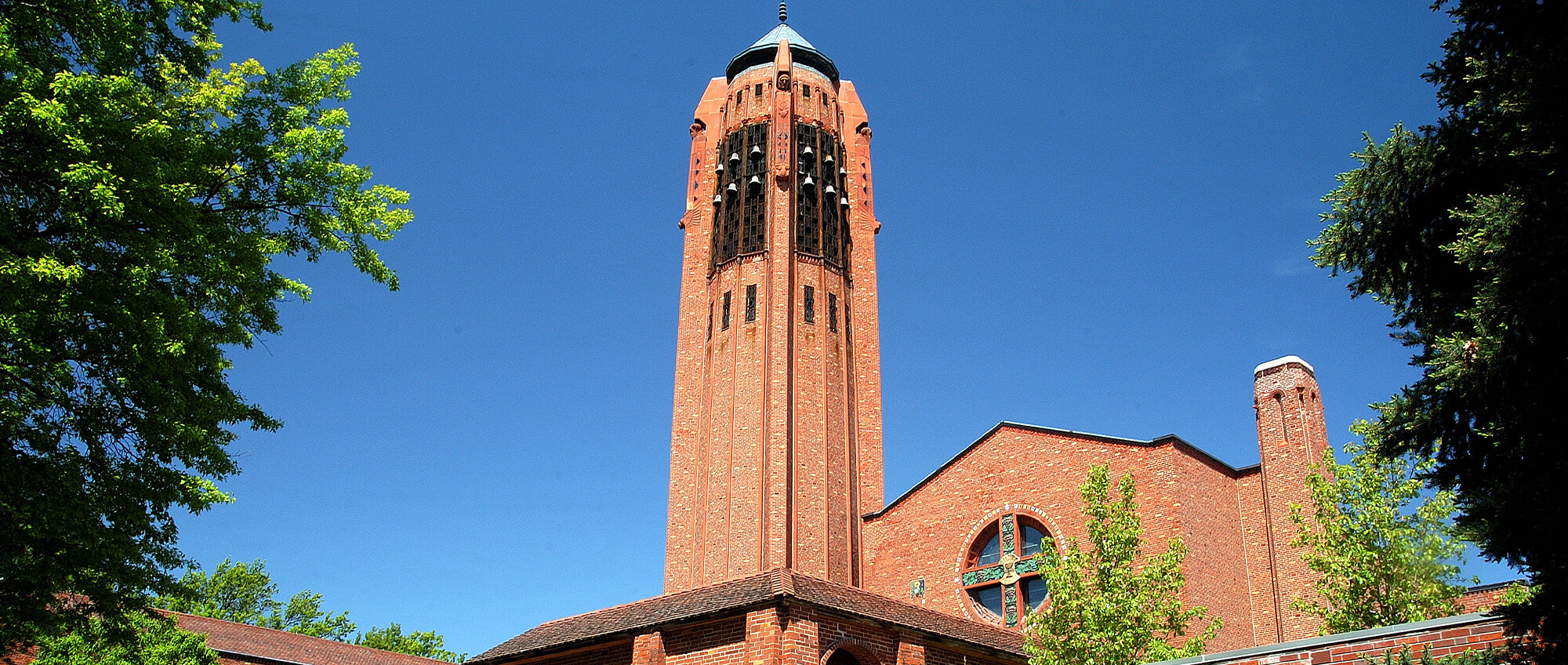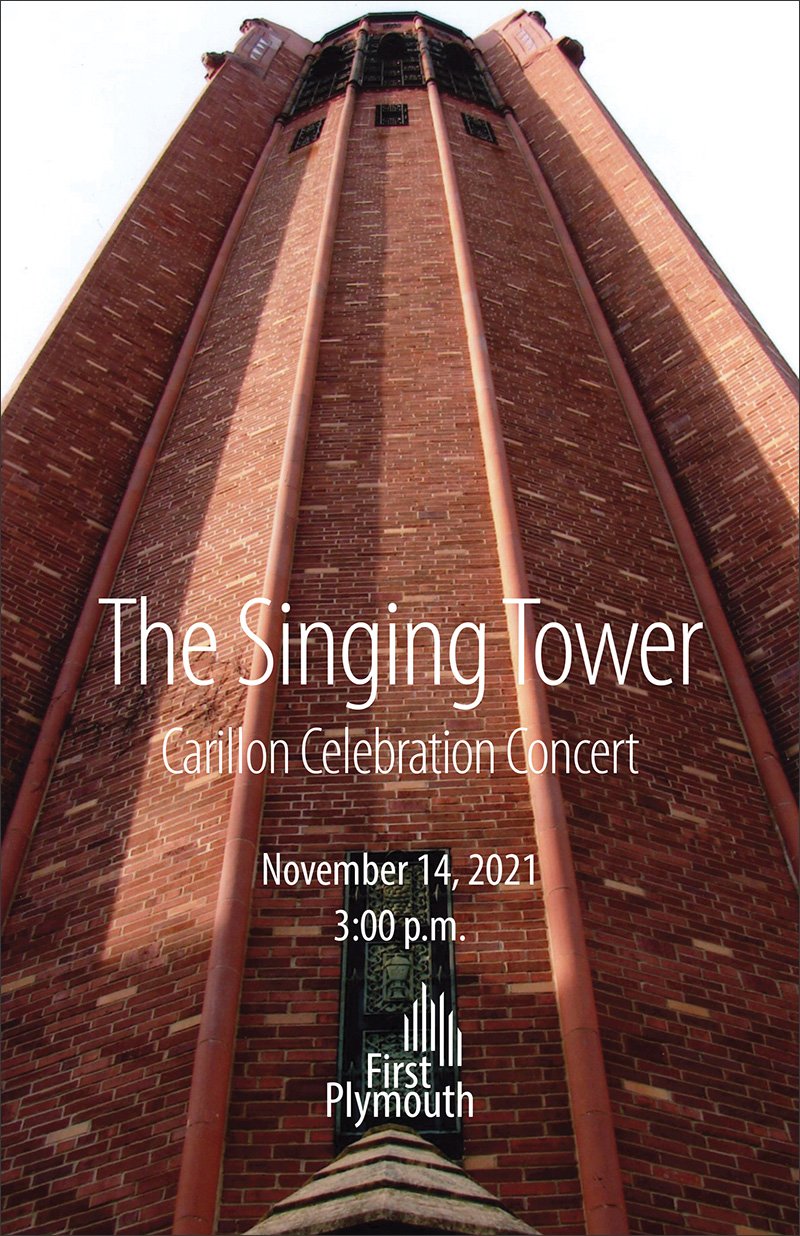
Carillon
Brief History of Carillons
The carillon is an extraordinary musical instrument with a history as rich as it is long. For more than five centuries, the carillon has been a voice for the hopes, aspirations and joys of humankind. The carillon is a musical instrument of at least 23 bells that are controlled by a player from a console or keyboard.
Carillons evolved in the lowlands of Holland, Belgium and northern France. The rich mercantile towns of the lowlands exhibited their status by installing fine carillons in their church towers and arranging tunes to be played every quarter hour - or still more often - by an automatic mechanism. The town carillonneur played on market days and holidays. It was said that good bells and good schools were the sign of a well-run city.
first-Plymouth’s Carillon
The Carillon was dedicated on Memorial Day, 1931 and the building on Easter Sunday, 1931, much work remained to be done at the time this picture was taken. The main items visible here are the incomplete tower, no round stained glass window over the main entrance, and the main entrance to the nave.
The 171-foot tall, sixteen-sided “Singing Tower” dominates the building. It houses Nebraska’s oldest true carillon, one of only three in the state. It originally contained 48 bells cast in the Taylor and Sons Foundry, Loughborough, England. The bells range in size from the largest of 4,592 pounds to the smallest of 130 pounds. A major renovation project in 1990 added nine bells and replaced 26 ofthe smaller bells.
Sculpted figures representing the evangelists Matthew, Mark, Luke, and John and located at the tower’s four corners, symbolically elevating the gospels of the New Testament, which are central to the Christian faith. Below each evangelist is a figure that represents the Gospel account associated with him: Matthew, the winged man – messenger of God’s good new is Jesus; Mark, the winged lion – the royal character of Jesus; Like the winged ox – the sacrifice of Jesus; and, John, the eagle – soaring high into the heavens.
At its dedication on May 30, the Sunday Journal and Star reported that 25,000 people flocked to the vicinity of 20th and D to hear the concert played by Anton Brees of Lake Worth, Florida, bellmaster of the Bok Singing Tower and foremost carilloneur in the United States. The lowest bell of the carillon is dedicated to Carrie Bell Raymond, the first Minister of Music at First-Plymouth Church. The largest bell, the low "C", weighing 4592 lbs is inscribed with her name. Mrs. Raymond also served as a Professor of Music at the University of Nebraska-Lincoln. Carrie Belle Raymond did not live to see the new church building rise at 20th & D Streets, but she is immortalized in the carillon of the "Singing Tower of First Plymouth", built by Taylor & Sons of England. Befitting her legacy, two of the most famous carilloneurs in the United States, Ronald Barnes and Milford Myhre developed their skill on this instrument as students of Myron Roberts at the University of Nebraska.
Technical
In 1931, the instrument was begun with 48 bells by Taylor (20 bells remain from that work.) A practice clavier mimicking the layout of the main carillon is housed in the church in the handbell rehearsal room.
Original Technical data:
Traditional carillon of 57 bells
Pitch of heaviest bell is C
Transposition is up 2 semitone(s)
Keyboard range: A#G / A#C 26
There is one missing bass semitone (B)
The 28 trebles were removed from the tower carillon when it was enlarged, with 4 recast and one added.
Additional Electric-keyboard (from organ) carillon of 29 bells
Pitch of heaviest bell is A#
Transposition is up 24 semitone(s)
Keyboard range: A#D / NONE
There are no missing bass semitones
The whole instrument was installed in 1989 with bells by Taylor (except for 5 by Whitechapel)
Pedals down to bass G are present in new clavier.
New bells cast 1988.
24 ornamental bells in belfry screen.
The instrument was enlarged in 1990 with 37 bells by Whitechapel
1990 Renovation
Renovated in 1990 by Timothy Hurd and associates. Timothy Hurd’s carillon firm, from Port Townsend, WA, is famous world-wide. Mr. Hurd and his brother has their own firm for the building and maintenance of carillons. The brothers started with the instrument from the 1930’s, kept the 21 lowest-toned bells and fashioned a new 57-bell carillon. They built a new carillon frame out of self-patinizing steel, so it never needs painting, and a solid stainless-steel transmission system. They repositioned the bells and clappers for better sound.

